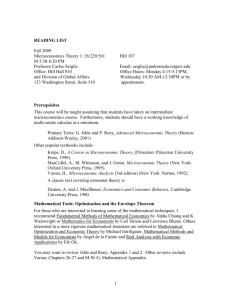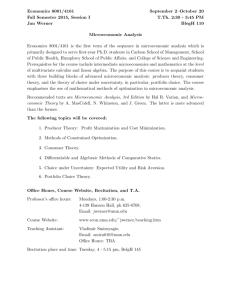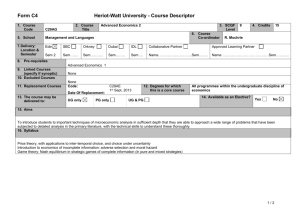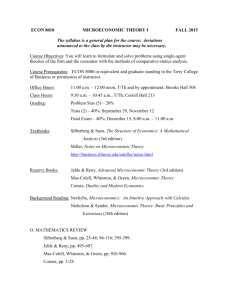Microeconomics - Rutgers Business School
advertisement
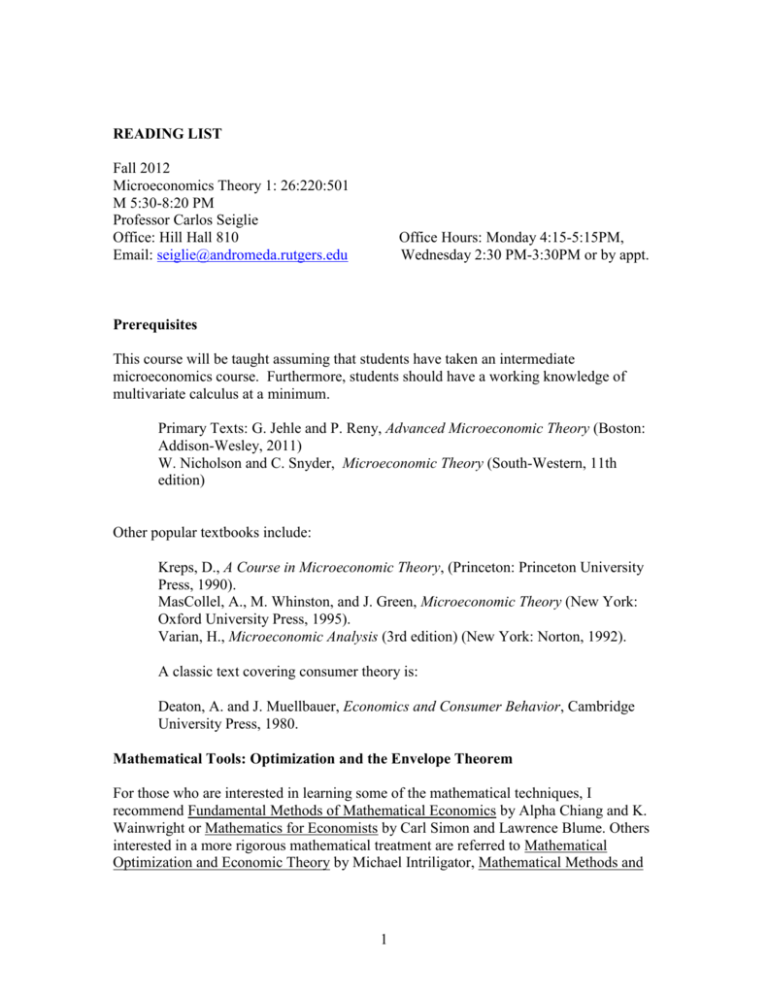
READING LIST Fall 2012 Microeconomics Theory 1: 26:220:501 M 5:30-8:20 PM Professor Carlos Seiglie Office: Hill Hall 810 Email: seiglie@andromeda.rutgers.edu Office Hours: Monday 4:15-5:15PM, Wednesday 2:30 PM-3:30PM or by appt. Prerequisites This course will be taught assuming that students have taken an intermediate microeconomics course. Furthermore, students should have a working knowledge of multivariate calculus at a minimum. Primary Texts: G. Jehle and P. Reny, Advanced Microeconomic Theory (Boston: Addison-Wesley, 2011) W. Nicholson and C. Snyder, Microeconomic Theory (South-Western, 11th edition) Other popular textbooks include: Kreps, D., A Course in Microeconomic Theory, (Princeton: Princeton University Press, 1990). MasCollel, A., M. Whinston, and J. Green, Microeconomic Theory (New York: Oxford University Press, 1995). Varian, H., Microeconomic Analysis (3rd edition) (New York: Norton, 1992). A classic text covering consumer theory is: Deaton, A. and J. Muellbauer, Economics and Consumer Behavior, Cambridge University Press, 1980. Mathematical Tools: Optimization and the Envelope Theorem For those who are interested in learning some of the mathematical techniques, I recommend Fundamental Methods of Mathematical Economics by Alpha Chiang and K. Wainwright or Mathematics for Economists by Carl Simon and Lawrence Blume. Others interested in a more rigorous mathematical treatment are referred to Mathematical Optimization and Economic Theory by Michael Intriligator, Mathematical Methods and 1 Models for Economists by Angel de la Fuente and Real Analysis with Economic Applications by Efe Ok. You may want to review Jehle and Reny, Appendix 1 and 2. Nicholson and Snyder, Chapters 1-3. Other reviews include Varian, Chapters 26-27 and M-W-G, Mathematical Appendix. THE ECONOMIC APPROACH TO HUMAN BEHAVIOR *Friedman, M., "The Methodology of Positive Economics," in Friedman, M., Essays in Positive Economics (U of C Press, 1966), pp. 3-43. *Becker, G., "The Economic Approach to Human Behavior," in Becker, G., The Economic Approach to Human Behavior, (U of C Press, 1976), pp. 3-14. DEMAND ANALYSIS AND PREFERENCES * Jehle and P. Reny, Advanced Microeconomic Theory, Chapters 1-2. Nicholson and Snyder, Chapters 3-7. *Rosen, S., “Hedonic Prices and Implicit Markets,” Journal of Political Economy 82 (January 1974): 34-55. *Becker, G., "A Theory of the Allocation of Time," Economic Journal 75, September 1965. Reprinted in Becker, G., The Economic Approach to Human Behavior, (U of C Press, 1976), Chapter 5. Deaton and Muellbauer, Economics and Consumer Behavior (Cambridge), chapters 1-4. Deaton and Muellbauer, chapters 5, 7, 10. Becker, G.S. and Murphy, K. M., "A Theory of Rational Addiction," Journal of Political Economy (4, August, 1988): 675-700. Chiappori, P., “Collective Labor Supply and Welfare,” Journal of Political Economy 100 (3, June 1992): 437-67. Hirshleifer, J. Investment, Interest, and Capital, Prentice Hall, Chapter 8. Deaton and Muellbauer, chapter 14. *Friedman, M. and Savage, L., "The Utility Analysis of Choices Involving Risk," in AEA, Readings in Price Theory. *Pauly, M., "The Economics of Moral Hazard," American Economic Review, June 1968: 531-37. Machina, M.J., "Choice Under Uncertainty: Problems Solved and Unsolved," Journal of Economic Perspectives 1 (Summer, 1987). Kreps, David, Microeconomic Theory, Chapter 3 SUPPLY OF PRODUCTS AND THE STRUCTURE OF FIRMS * Jehle and P. Reny, Advanced Microeconomic Theory, Chapter 3-4. Nicholson and Snyder, Chapters 9-15. *Friedman, Milton, Price Theory (Aldine 1976), chapter 5. Stigler, G.J., Theory of Price, 4th ed. (Macmillan, 1988), ch. 7-9. 2 Topel, R. and Rosen, S., “Housing Investment in the United States”, Journal of Political Economy, (1988): 718-740. Rosen, S.,“The Economics of Superstars,” American Economic Review, 1981. Romer, P., “Increasing Returns and Long-Run Growth,” Journal of Political Economy 94 (October, 1986): 1002-37. Pindyck, Robert S. “Irreversibility, Uncertainty, and Investment,” Journal of Economic Literature, (September 1991): 1110-1152. *Arrow, K. "The Economic Implications of Learning by Doing," Review of Economic Studies (June 1962). Nordhaus, W.D. “Do Real Output and Real Wage Measures Capture Reality? The History of Lighting suggests not.” in Bresnahan and R.A Gordon, The Economics of New Goods, (1997): 29-66. Carlton and Perloff, Modern Industrial Organization (Scott-Foresman, 1990), chapter 3. *Coase, Ronald, "The Nature of the Firm," Economica, 1937; reprinted in Stigler and Boulding (eds.), Readings in Price Theory. Grossman and Hart, "The Costs and Benefits of Ownership: A Theory of Lateral and Vertical Integration," Journal of Political Economy 94 (1986): 691-719. *Coase, Ronald, "The Problem of Social Cost," Journal of Law and Economics 3 (1960): 1-44. *Alchian, A.A. and Demsetz, H., "Production, Information Costs, and Economic Organization," American Economic Review, 1972 Holmstrom, Bengt, "Moral Hazard in Teams," Bell Journal of Economics 13 (Autumn,1982): 324-40. MARKET EQUILIBRIUM *Jehle and P. Reny, Advanced Microeconomic Theory, Chapters 5 and 8. Jehle and P. Reny, Advanced Microeconomic Theory, Chapter 9. Hildebrand and Kerman, Introduction to Equilibrium Analysis, ch. 1. Mas-Colell, A, Whinston, M. and Green, J., Microeconomic Theory, Chapters 13-16, 1720 Jones, R. “The Structure of Simple General Equilibrium Models, “Journal of Political Economy, 1965. *Stigler, G.J., "Economics of Information," Journal of Political Economy 72 (Feb. 1964): 44-61. *Hayek, F.A., "The Use of Knowledge in Society," American Economic Review 35 (September 1945): 519-30. *Akerlof, George, "The Market for Lemons: Qualitative Uncertainty and the Market Mechanism," Quarterly Journal of Economics 84 (1970): 481-500. *Rothschild, M. and Stiglitz, J., "Equilibrium in Competitive Insurance Markets," Quarterly Journal of Economics, 1976. Kreps, op cit, chapters 6, 16, 17 Rubenstein, A., "Perfect Equilibrium in a Bargaining Model," Econometrica, 1982: 97110. Carlton and Perloff, chapter 6. 3 Roth, Alvin, "The Evolution of the Labor Market for Medical Interns and Residents: A Case Study in Game Theory," Journal of Political Economy 92 (1984): 991-1016. *Lazear, E. and Rosen, S., "Rank-Order Tournaments as Optimal Labor Contracts," Journal of Political Economy 89 (1981): 841-64. Tirole, Jean, The Theory of Industrial Organization (MIT Press, 1988), Chapter 3, sections 3.0-3.4. *Alchian, A.A., "Uncertainty, Evolution, and Economic Theory," Journal of Political Economy 58 (3, June 1950): 211-21. BUSINESS PRACTICES AND MARKET STRUCTURE Carlton and Perloff, Chs. 9, 11, 19, 20. Dixit, A. and J. Stiglitz, “Monopolistic Competition and Optimum Product Diversity,” American Economic Review 67 (1977). Spence, Michael, "Product Selection, Fixed Costs and Monopolistic Competition," Review of Economic Studies 43 (1976): 217-35. Tirole, op cit., Chapters 5.0-5.6, 6.0-6.6, 8.0-8.2, 9.0-9.4. Baumol, W., Panzer, J, and Willig, R., Contestable Markets and the Theory of Industry Structure (Harcourt Brace, 1982), ch. 2. Loury, G.C., "Market Structure and Innovation," Quarterly Journal of Economics (August 1979): 395-410. Farrell, J., and Saloner G. "Standardization, Compatibility and Innovation," Rand Journal, 1985: 70-83. *Klein, Benjamin and Leffler, Keith B., "The Role of Market Forces in Assuring Contractual Performance," Journal of Political Economy 89 (August 1981):615-41. * indicates required reading 4
